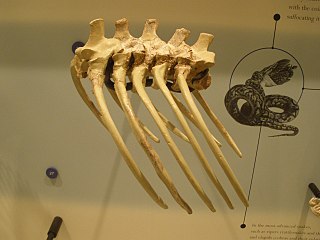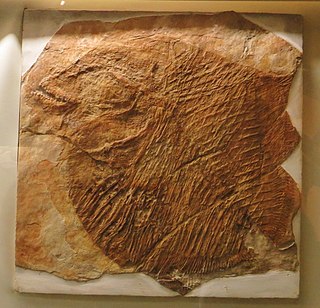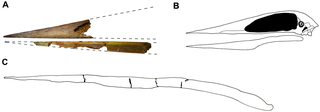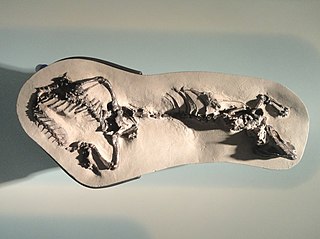
Ophidia is a group of squamate reptiles including modern snakes and reptiles more closely related to snakes than to other living groups of lizards.

Spinosaurus is a genus of spinosaurid dinosaur that lived in what now is North Africa during the Cenomanian stage of the Late Cretaceous period, about 100 to 94 million years ago. The genus was known first from Egyptian remains discovered in 1912 and described by German palaeontologist Ernst Stromer in 1915. The original remains were destroyed in World War II, but additional material came to light in the early 21st century. It is unclear whether one or two species are represented in the fossils reported in the scientific literature. The type species is S. aegyptiacus from Egypt and Morocco. Although a potential second species, S. maroccanus, has been recovered from Morocco, this dubious species is likely a junior synonym of S. aegyptiacus. Other possible junior synonyms include Sigilmassasaurus from the Kem Kem beds in Morocco and Oxalaia from the Alcântara Formation in Brazil, though other researchers propose both genera to be distinct taxa.

Carcharodontosaurus is a genus of carnivorous theropod dinosaur that lived in North Africa from about 100 to 94 million years ago during the Cenomanian age of the Late Cretaceous. Two teeth of the genus, now lost, were first described from Algeria by French paleontologists Charles Depéret and Justin Savornin as Megalosaurus saharicus. A partial skeleton was collected by crews of German paleontologist Ernst Stromer during a 1914 expedition to Egypt. Stromer did not report the Egyptian find until 1931, in which he dubbed the novel genus Carcharodontosaurus, making the type species C. saharicus. Unfortunately, this skeleton was destroyed during the Second World War. In 1995 a nearly complete skull of C. saharicus, the first well-preserved specimen to be found in almost a century, was discovered in the Kem Kem Beds of Morocco; it was designated the neotype in 1996. Fossils unearthed from the Echkar Formation of northern Niger were described and named as another species, C. iguidensis, in 2007.

Rebbachisaurus is a genus of sauropod dinosaur of the superfamily Diplodocoidea, that lived during the Late Cretaceous period in Africa and possibly also South America about 99-97 million years ago. Remains attributed to Rebbachisaurus have been found in Morocco, Niger, Algeria, Tunisia and possibly also Argentina, although only the Moroccan remains can be referred to the genus without doubt. The discovery of Rayososaurus, a South American sauropod nearly identical to Rebbachisaurus which may have actually have been the same animal as Rebbachisaurus, supports the theory that there was still a land connection between Africa and South America during the Early Cretaceous, long after it was commonly thought the two continents had separated.

Sigilmassasaurus is a controversial genus of spinosaurid dinosaur that lived approximately 100 to 94 million years ago during the Late Cretaceous Period in what is now northern Africa. Named in 1996 by Canadian paleontologist Dale Russell, it contains a single species, Sigilmassasaurus brevicollis. The identity of the genus has been debated by scientists, with some considering its fossils to represent material from the closely related species Spinosaurus aegyptiacus, while others have classified it as a separate taxon, forming the clade Spinosaurini with Spinosaurus as its sister taxon.

Madtsoiidae is an extinct family of mostly Gondwanan snakes with a fossil record extending from early Cenomanian to late Pleistocene strata located in South America, Africa, India, Australia and Southern Europe. Madtsoiidae include very primitive snakes, which like extant boas and pythons would likely dispatch their prey by constriction. Genera include some of the longest snakes known such as Vasuki, measuring at least 11–15 metres (36–49 ft) long, and the Australian Wonambi and Yurlunggur. As a grouping of basal forms the composition and even the validity of Madtsoiidae is in a state of flux as new pertinent finds are described, with more recent evidence suggesting that it is paraphyletic as previously defined.

Axelrodichthys is an extinct genus of mawsoniid coelacanth from the Cretaceous of Africa, North and South America, and Europe. Several species are known, the remains of which were discovered in the Lower Cretaceous (Aptian-Albian) of Brazil, North Africa, and possibly Mexico, as well as in the Upper Cretaceous of Morocco (Cenomanian), Madagascar and France. The Axelrodichthys of the Lower Cretaceous frequented both brackish and coastal marine waters while the most recent species lived exclusively in fresh waters. The French specimens are the last known fresh water coelacanths. Most of the species of this genus reached 1 metre to 2 metres in length. Axelrodichthys was named in 1986 by John G. Maisey in honor of the American ichthyologist Herbert R. Axelrod.

The Kem Kem Group is a geological group in the Kem Kem region of eastern Morocco, whose strata date back to the Cenomanian stage of the Late Cretaceous. Its strata are subdivided into two geological formations, with the lower Ifezouane Formation and the upper Aoufous Formation used for the strata on the eastern side of the Atlas Mountains (Tinghir), with the Gara Sbaa Formation and Douira Formation used in the southern Tafilalt region. It is exposed on an escarpment along the Algeria–Morocco border.
Cladocyclus is an extinct genus of marine ichthyodectiform fish from the middle Cretaceous. It was a predatory fish of about 1.20 metres (3.9 ft) in length.

Coelodus is an extinct genus of marine and possibly freshwater pycnodont fish. It contains only one definitive species, C. saturnusHeckel, 1854, from the Late Cretaceous of Slovenia. Other species from the Late Jurassic to the Eocene have also been attributed to this genus based on isolated dental elements, but their assignment to Coelodus is uncertain, and this genus likely represents a non-monophyletic wastebasket taxon. A potential diagnostic trait is a prearticular tooth row with three regular highly elongated teeth.

Alanqa is a genus of pterodactyloid pterosaur from the Late Cretaceous period of what is now the Kem Kem Beds of southeastern Morocco. The name Alanqa comes from the Arabic word العنقاءal-‘Anqā’, for a mythical bird of Arabian culture.

Onchopristis is an extinct genus of sclerorhynchoid from the Cretaceous of North Africa, Europe, and North America. Its name is derived from the Ancient Greek ónkos and prístis. It contains two valid species, O. numida and O. dunklei, though some researchers argue that both may be considered a single taxon with variation in morphology caused by a wide geographical range. Specimens of Onchopristis have been discovered in coastal and fluvial deposits dated from the Barremian to the Maastrichtian age, making this genus one of the oldest and longest-lived sclerorhynchoid genera.

Polyglyphanodontia, also known as the Borioteiioidea, is an extinct clade of Cretaceous lizards. Polyglyphanodontians were the dominant group of lizards in North America and Asia during the Late Cretaceous.
The Aoufous Formation is a geological formation that contains some of the vertebrate assemblage of the Kem Kem Group, of Late Cretaceous date. Two other formations comprise the Kem Kem beds: the underlying Ifezouane Formation and the overlying Akrabou Formation.

Coniophis is an extinct genus of snakes from the late Cretaceous period. The type species, Coniophis precedes, was about 7 cm long and had snake-like teeth and body form, with a skull and a largely lizard-like bone structure. It probably ate small vertebrates. The fossil remains of Coniophis were first discovered at the end of the 19th century in the Lance Formation of the US state of Wyoming, and were described in 1892 by Othniel Charles Marsh. For the genus Coniophis, a number of other species have been described. Their affiliation is, however, poorly secured, mostly based on vertebrae descriptions from only a few fossils.
Xericeps is a genus of pterosaur from the Cenomanian stage of the Late Cretaceous. It was discovered from the Kem Kem Beds of southeastern Morocco.

Concavotectum is an extinct genus of freshwater plethodid ray-finned fish that lived during the Cenomanian in Morocco and possibly Egypt. It was discovered and named in 2008 and is known from a single well preserved hand-sized skull and a few isolated vertebrae discovered in the Kem Kem Group. The type species, C. moroccensis, was named in 2008 and described in 2010.
Pouitella is an extinct genus of terrestrial ophidian known from the Cenomanian of Brézé and Lussant, France and was first described by J-C. Rage in 1988. Only the type species, P. pervetus is known and the holotype consists only of middle trunk vertebrae.

Lapparentophiidae are an extinct family of basal terrestrial ophidians known from Early-Late Cretaceous (?Albian-Cenomanian)-aged fossil remains discovered in Algeria, France, Morocco and Sudan. Two genera are known: the type species, Lapparentophis and the poorly represented genus Pouitella.

The Akrabou Formation is a Late Cretaceous -aged geological formation and Konservat-Lagerstätte in Morocco. It overlies the slightly older freshwater deposits of the Kem Kem Group, which it was once thought to be apart of. It was deposited over following the Kem Kem ecosystem's submergence by the Tethys Ocean during a marine transgression from the Cenomanian-Turonian boundary event, as part of a wider deposition of carbonate platforms across the region from the event.
















